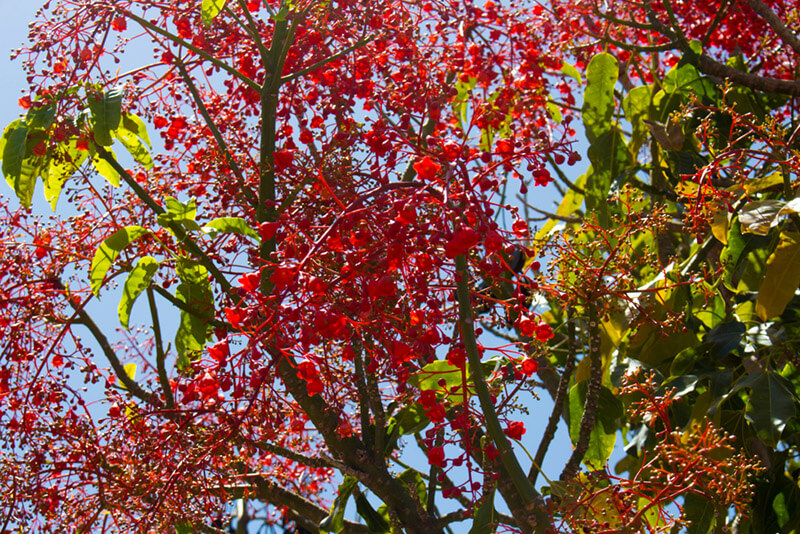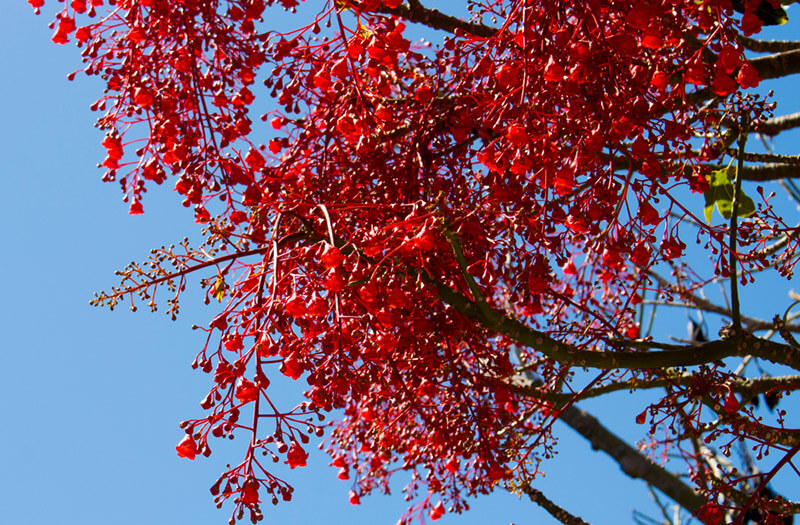
The Secrets To The Australian Flame Tree
Published: 23/08/2022 | Updated: 29/03/2023
Beautiful skies, beautiful people, beautiful landscapes and beautiful wildlife that will make your trip memorable in more ways than one, it’s none other than Australia. Even though we could go on and on about the unbelievable beauty that endlessly blossoms there, we are here to focus on the Australian Flame Tree also known as the Illawarra Flame Tree.


There are few lesser-known secrets when it comes to the Australian Flame Tree and the landscape design experts at ShrubHub think it’s time to reveal them.
The History Of The Australian Flame Tree
Native to Australia the Flame Tree is a true sight of beauty that can’t be missed. In Australia, these trees have a long history, especially with the natives. According to Russell Barrett, a systematic botanist at the Royal Botanic Garden Sydney, Aboriginal Australians used the inner bark of flame trees as a food source and to make string, fishing nets, and traps.
The huge seeds have a taste very similar to a modern day raw peanut and are very high in protein, according to Russell. To guarantee that all the bothersome hairs were burned off, they were frequently boiled before consumption.
Their truly unforgettable bright red blooms, which appear in late spring and follow the purple jacarandas, are a lucky sight that is common throughout Australia. The Illawarra flame tree (brachychiton acerifolius), which may be found throughout New South Wales and along the east coast of Queensland, is in full bloom.
Here's a quick overview of flame trees and how to grow one in case you've been intrigued about this brilliant scarlet tree and its bell-shaped blossoms.
How To Recognize an Australian Flame Tree
The leathery, green leaves of this tree come in a range of sizes and shapes. While older trees have leaves that are shallow, young plants grow leaves that are deeply lobed. Australian flame trees, whether they flower or not, are deciduous, and their leaves fall off in the spring. At the extremities of bare branches, enormous, hanging clusters of 1-inch-tall, waxy, crimson bells develop. Fruits are masses of yellow seeds enclosed in 4-inch black seedpods that are strikingly similar to corn kernels despite not being closely related to corn.
Let’s dive into why you're really here, how to grow, care and watch the Australian Flame Tree in your own backyard.
The blooms in the Illawarra region can draw local butterflies and provide plenty of space for birds to build their nests. If you decide to plant one, be prepared to share your yard with some local wildlife!
How To Grow The Australian Flame Tree
Australian flame trees are mostly subtropical, but don't give up hope! They also thrive in temperate areas and grow to be around 60 feet tall! Let’s get into some details and find out if this might be the one tree you didn’t know you needed to complete your yard! Firstly let’s outline the basic needs for this gorgeous tree.
- Sun Requirements : Full Sun to Half Shade
- Irrigation & Water Requirements : After planting, water well while the tree is still young; once established, water usage is low making it a fantastic low maintenance plant to have, just make sure it gets proper drainage!
- Soil & Fertilizer : They can tolerate most types of soil matter (As long as you keep organic material away from the trunk, you can mulch the base with it. Feed in the fall and spring if fertilizer is required)
- Soil pH : We recommend either neutral, acidic or alkaline type soil.
- Ideal Climate : Best suited to temperate and tropical areas throughout the year but can survive in temperatures that stay humid and around 60° (Light frost is not harmful to flame trees, but be careful to check on them during the winter!)
- Pruning : This is preferred in late summer, following the flame tree's flowering cycle. To maintain its shape and vitality, prune any branches that are dead or damaged. To prevent leaves from getting too big, you can prune them two to three times every year.
- Mature Size : 40-70 feet wide and 30-40 feet tall is the average height for this type of plant.
- Blooming Season : Summer and Spring
- Most Common Coloring : Orange & Red
Step One : Choose an area in your yard that fits the above mentioned light and soil requirements and make sure to research the climate in your area the past 2 years to make sure the weather conditions are adequate.
(It's crucial to remember that if you plant a flame tree too close to a structure, its roots are seen as invasive. If you want to plant a tree in your backyard, keep it 10 meters away from any structures, especially your house, as the roots could harm the foundational ones.)
Step Two : Decide on your choice of start, whether its a seedling (we’ll get into how to grow one from a seedling) or a nursery plant, If you choose a nursery plant make sure that when you plant them the hole is at least twice as large as the ball of the root (make sure the roots aren’t tangled or circled, we suggest gently teasing them) and a little bit deeper for flexibility.
Step Three : Make sure the positioning of your plant has a good raised ring around it. This will allow the water to reach the roots and the area that needs the water the most. After that you can go ahead and supply it with some water.
Step Four : If you decide to use mulch or fertilizer go ahead and add it far away from the trunk of the nursery plant.
Step Five (Last But Not Least) : Make sure you regularly maintain your plant around the autumn and spring by providing it with nutrients if your soil isn’t nutrient dense.
Tips For Growing Flame Trees From Seeds

- Make sure to source your seeds from a reputable garden shop whether online or in store to ensure the seeds aren’t dead.
- You can also harvest these seeds if you or a friend has an existing flame tree! All you need to do is take the seeds from the fallen dark brown pods that fall around the springtime.
- Before putting the seeds in potting soil, soften the seed coat by soaking them in warm water for a day or two.
- By lightly nicking or scratching each softening seed with a knife, you can scarify them, which lets water in and stimulates the germination process. Some gardeners advise peeling the seed by briefly touching it with sandpaper.
- A 3- to 6-inch deep seed tray should be filled with well-draining potting soil. Each seed should be planted 3 inches apart, 1 inch deep. Around each seed, firmly pat the soil.
- Place the tray in a warm spot outside that is somewhat shaded. Don't overwater the seedlings; just keep it damp. In four to six days, seeds should start to bud.
- Transfer seedlings that are 8 inches tall to a 1-gallon container. As your seedlings mature, move them around more often until you are prepared to choose a location in your landscape for the tree to take root.
Growing Flame Trees In Pots
The flame tree can be grown and trained as a bonsai even if it is too large to be cultivated in pots. Therefore, it will need to be potted every two years.
Pests & Plant Diseases to Look Out For
Although there aren't many pests on flame trees, some caterpillar species may eat the foliage. It shouldn't, however, completely defoliate the tree. Spider mites can also be a problem, especially if the tree is not in a wet area. Increase the humidity or move the plant outside if you find spider mites. Scale bugs might also be a problem. They'll show up under the leaves, but cotton swabs dipped in alcohol will get rid of them.
A fungus called Phellinus noxious has the potential to make the roots rot. Lessening the likelihood that this fungus will invade might be accomplished by selecting a location with well-draining soil.
And that’s all you need to grow your very own blossoming flame tree!
When it comes to choosing the perfect trees and plants for your backyard it might be best to use a professional consultant; it lessens the work and research for you, ensures you’re getting high quality advice, and allows you to explore a lot of different options!
A great affordable virtual design option is ShrubHub’s Online Design Package. ShrubHub includes a 1-on-1 design consultation as well as a full 3D landscaping and hardscaping design depending on what you need, everything from a full plant legend, locations and a plant consultation to ensure everything is perfect for you!
Check out ShrubHub today for a special 70% off discount!


